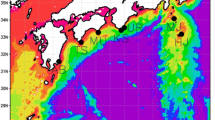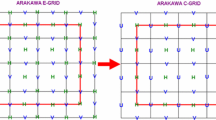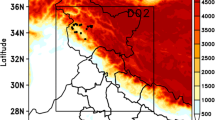Abstract
In this paper, a data assimilation scheme based on the adjoint free Four-Dimensional Variational(4DVar) method is applied to an existing storm surge model of the German North Sea. To avoid the need of an adjoint model, an ensemble-like method to explicitly represent the linear tangent equation is adopted. Results of twin experiments have shown that the method is able to recover the contaminated low dimension model parameters to their true values. The data assimilation scheme was applied to a severe storm surge event which occurred in the North Sea in December 5, 2013. By adjusting wind drag coefficient, the predictive ability of the model increased significantly. Preliminary experiments have shown that an increase in the predictive ability is attained by narrowing the data assimilation time window.










Similar content being viewed by others
References
Abdalla S, Cavaleri L (2002) Effect of wind variability and variable air density on wave modeling. J Geophys Res: Oceans (1978–2012) 107(C7):17–1
Bode L, Hardy TA (1997) Progress and recent developments in storm surge modeling. J Hydraul Eng 123 (4):315–331
Bruss G, Gönnert B, Mayerle R (2011) Extreme scenarios at the german north sea coast a numerical model study. Coast Eng Proc 1(32):26
Bruss G, Mayerle R (2009) Investigations on the influence of the wind drag coefficient in storm surge models. In: Proceedings of the 3rd International Conference in Ocean Engineering, pp 325–332
Charnock H (1955) Wind stress on a water surface. Q J R Meteorol Soc 81(350):639–640
COSMO (2007) Operations at dwd. Technical report, cosmo-eu
Donelan MA, Dobson FW, Smith SD, Anderson RJ (1993) On the dependence of sea surface roughness on wave development. J Phys Oceanogr 23(9):2143–2149
Dube S, Jain I, Rao A, Murty T (2009) Storm surge modelling for the bay of bengal and arabian sea. Nat Hazards 51(1):3–27
Egbert GD, Erofeeva SY (2002) Efficient inverse modeling of barotropic ocean tides. J Atmos Ocean Technol 19(2):183–204
Elias E, Walstra D, Roelvink J, Stive M, Klein M (2001) Hydrodynamic validation of delft3d with field measurements at egmond. In: Coastal Engineering Conference, vol 3. Asce American Society Of Civil Engineers, pp 2714–2727
Evensen G (1994) Sequential data assimilation with a nonlinear quasi-geostrophic model using monte carlo methods to forecast error statistics. J Geophys Res: Oceans 99(C5):10143–10162
Fernandez Jaramillo JM (2014). In: Development of an Operational System for a Coastal Area on the German North Sea using Artificial Intelligence. PhD Thesis, Kiel, Christian-Albrechts-Universität, Dissertation
Fritz HM, Blount C, Sokoloski R, Singleton J, Fuggle A, McAdoo BG, Moore A, Grass C, Tate B (2007) Hurricane katrina storm surge distribution and field observations on the mississippi barrier islands. Estuar Coast Shelf Sci 74(1):12–20
Garratt J (1977) Review of drag coefficients over oceans and continents. Monthly Weather Rev 105(7):915–929
Guan C, Xie L (2004) On the linear parameterization of drag coefficient over sea surface. J Phys Oceanogr 34(12):2847–2851
Holland GJ (1980) An analytic model of the wind and pressure profiles in hurricanes. Monthly Weather Rev 108(8):1212–1218
Horsburgh K, Wilson C (2007) Tide-surge interaction and its role in the distribution of surge residuals in the north sea. J Geophys Res: Oceans (1978–2012) 112(C8)
Hsu S-A (1974) A dynamic roughness equation and its application to wind stress determination at the air-sea interface. J Phys Oceanogr 4(1):116–120
Hydraulics D (2011) User manual delft3d-flow: Wl. Delft Hydraulics
Jiao J (2014) Morphodynamics of Ameland Inlet: Mediumterm Delft3D Modelling
Johnson H, Vested H (1992) Effects of water waves on wind shear stress for current modeling. J Atmos Ocean Technol 9(6):850–861
Kitaigorodskii S, Volkov YA (1965) On the roughness parameter of the sea surface and the calculation of momentum flux in the near-water layer of the atmosphere. Izv Atmos Oceanic Phys 1:973–988
Lawless AS (2012) Variational data assimilation for very large environmental problems. Large Scale Inverse Problems: Computational Methods and Applications in the Earth Sciences, Radon Series on Computational and Applied Mathematics 13:55–90
Li Y, Peng S, Yan J, Xie L (2013) On improving storm surge forecasting using an adjoint optimal technique. Ocean Model 72:185–197
Lin W, Sanford LP, Suttles SE, Valigura R (2002) Drag coefficients with fetch-limited wind waves*. J Phys Oceanogr 32(11):3058–3074
Liu M, Lv X (2011) Study on the drag coefficient in the simulation of storm surges with adjoint method. Oceanol Limnol Sin 1:002
Lorenc A, Ballard S, Bell R, Ingleby N, Andrews P, Barker D, Bray J, Clayton A, Dalby T, Li D et al (2000) The met. office global three-dimensional variational data assimilation scheme. Q J R Meteorol Soc 126(570):2991–3012
Lowe JA, Gregory JM, Flather RA (2001) Changes in the occurrence of storm surges around the United Kingdom under a future climate scenario using a dynamic storm surge model driven by the hadley centre climate models. Clim Dyn 18(3-4):179–188
Marotzke J, Giering R, Zhang KQ, Stammer D, Hill C, Lee T (1999) Construction of the adjoint mit ocean general circulation model and application to atlantic heat transport sensitivity. J Geophys Res: Oceans 104(C12):29529–29547
Mayerle R, Zielke W (2005) Promorph–predictions of medium-scale morphodyanimcs: project overview and executive summary. Die Küste 69:1–24
Moore AM (1991) Data assimilation in a quasi-geostrophic open-ocean model of the gulf stream region using the adjoint method. J Phys Oceanogr 21(3):398–427
Moore AM, Arango HG, Broquet G, Powell BS, Weaver AT, Zavala-Garay J (2011) The regional ocean modeling system (roms) 4-dimensional variational data assimilation systems: Part i–system overview and formulation. Prog Oceanogr 91(1):34–49
Nocedal J, Wright S (2006) Numerical optimization. Springer Science & Business Media
Pawlowicz R, Beardsley B, Lentz S (2002) Classical tidal harmonic analysis including error estimates in matlab using t_tide. Comput Geosci 28(8):929–937
Peng S, Li Y, Xie L (2013) Adjusting the wind stress drag coefficient in storm surge forecasting using an adjoint technique. J Atmos Ocean Technol 30(3):590–608
Rabier F, Järvinen H, Klinker E, Mahfouf J-F, Simmons A (2000) The ecmwf operational implementation of four-dimensional variational assimilation. i: experimental results with simplified physics. Q J R Meteorol Soc 126(564):1143–1170
Smith S, Banke E (1975) Variation of the sea surface drag coefficient with wind speed. Q J R Meteorol Soc 101(429):665–673
Smith SD (1980) Wind stress and heat flux over the ocean in gale force winds. J Phys Oceanogr 10(5):709–726
Stewart R (1974) The air-sea momentum exchange. Bound-Layer Meteorol 6(1-2):151–167
Verboom G, de Ronde J, van Dijk R (1992) A fine grid tidal flow and storm surge model of the north sea. Cont Shelf Res 12(2–3):213–233
Von Storch H, Gönnert G, Meine M (2008) Storm surge—an option for hamburg, Germany, to mitigate expected future aggravation of risk. Environ Sci Policy 11(8):735–742
Weaver RJ (2004) Effect of wave forcing on storm surge. Master’s Thesis, University of Florida
Weisberg RH, Zheng L (2008) Hurricane storm surge simulations comparing three-dimensional with two-dimensional formulations based on an ivan-like storm over the tampa bay, florida region. J Geophys Res: Oceans (1978–2012) 113(C12)
Woodworth PL, Smith DE (2003) A one year comparison of radar and bubbler tide gauges at liverpool. Inter Hydrogr Rev 4(3)
Wu J (1980) Wind-stress coefficients over sea surface near neutral conditions—a revisit. J Phys Oceanogr 10 (5):727–740
Yu L, O’Brien JJ (1991) Variational estimation of the wind stress drag coefficient and the oceanic eddy viscosity profile. J Phys Oceanogr 21:709–719
Zhang A, Wei E, Parker BB (2003) Optimal estimation of tidal open boundary conditions using predicted tides and adjoint data assimilation technique. Cont Shelf Res 23(11–13):1055–1070
Acknowledgments
This study has been conducted using the tidal gauges data of Copernicus Marine Service Products
Author information
Authors and Affiliations
Corresponding author
Additional information
Responsible Editor: Yign Noh
This article is part of the Topical Collection on the 7th International Workshop on Modeling the Ocean (IWMO) in Canberra, Australia 1-5 June 2015
Appendix
Appendix
The wind profile follows approximately a logarithm curve with height in the atmospheric boundary layer which can be expressed as:
where U(z) is the wind speed at the height of z; z 0 is the aerodynamic surface roughness; κ = 0.4 is the von Karman constant; u ∗ is the wind friction velocity defined by:
Combining Eqs. 1 and A.2, a relation between u ∗ and C d can be obtained as follows:
Combining (A.1) and Eq. A.3 yields the relation between z 0 and C d ,
where z 10=10m. Charnock (1955) proposed a relation between z 0 and u ∗ , i.e., \(gz_{0}/u_{*}^{2}=\alpha \), where g is the gravitational acceleration and α is the Charnock coefficient. Charnock (1955) took it as a constant. Combining all the above equations, a relation between C d and U 10 is obtained as below,
Equation A.5 is almost a linear function for C d values in the range of 1.0 × 10−3 to 4.0 × 10−3,
where b = 0.475α 1/2. Several values of α have been proposed; α = 0.012 (Charnock 1955); α = 0.0144 (Garratt 1977) ; α = 0.035 (Kitaigorodskii and Volkov 1965) . Stewart (1974) suggested a dependency of α with the wave state. Hsu (1974) related α to the wave steepness and Donelan et al. (1993) to the wave age.
Rights and permissions
About this article
Cite this article
Zheng, X., Mayerle, R., Xing, Q. et al. Adjoint free four-dimensional variational data assimilation for a storm surge model of the German North Sea. Ocean Dynamics 66, 1037–1050 (2016). https://doi.org/10.1007/s10236-016-0962-y
Received:
Accepted:
Published:
Issue Date:
DOI: https://doi.org/10.1007/s10236-016-0962-y




